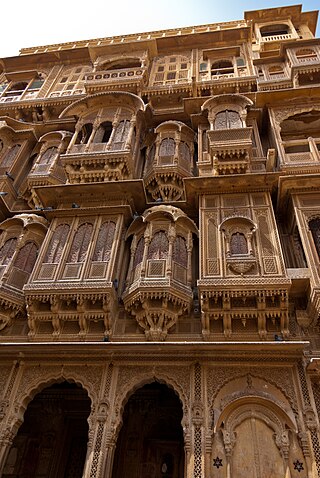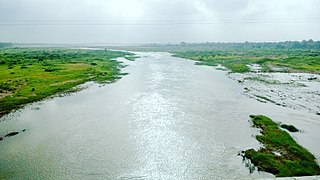
Rajasthan is a state in northwestern India. It covers 342,239 square kilometres (132,139 sq mi) or 10.4 per cent of India's total geographical area. It is the largest Indian state by area and the seventh largest by population. It is on India's northwestern side, where it comprises most of the wide and inhospitable Thar Desert and shares a border with the Pakistani provinces of Punjab to the northwest and Sindh to the west, along the Sutlej-Indus River valley. It is bordered by five other Indian states: Punjab to the north; Haryana and Uttar Pradesh to the northeast; Madhya Pradesh to the southeast; and Gujarat to the southwest. Its geographical location is 23°.3' to 30°.12' North latitude and 69°.30' to 78°.17' East longitude, with the Tropic of Cancer passing through its southernmost tip.
Tourism in India is 4.6% of the country's gross domestic product (GDP). Unlike other sectors, tourism is not a priority sector for the Government of India. The World Travel and Tourism Council calculated that tourism generated ₹13.2 lakh crore (US$150 billion) or 5.8% of India's GDP and supported 32.1 million jobs in 2021. Even though, these numbers were lower than the pre-pandemic figures; the country's economy witnessed a significant growth in 2021 after the massive downturn during 2020. The sector is predicted to grow at an annual rate of 7.8% to ₹33.8 lakh crore (US$400 billion) by 2031. India has established itself as the 5th largest global travel healthcare destination with an estimated market size of around $9 billion in 2019, out of the total global travel healthcare industry of $44.8 billion(2019). In 2014, 184,298 foreign patients travelled to India to seek medical treatment.

A haveli is a traditional townhouse, mansion, or manor house, in the Indian subcontinent, usually one with historical and architectural significance, and located in a town or city. The word haveli is derived from Arabic hawali, meaning "partition" or "private space", popularised under the Mughal Empire, and was devoid of any architectural affiliations. Later, the word haveli came to be used as a generic term for various styles of regional mansions, manor houses, and townhouses found in the Indian subcontinent.

Chhatri are semi-open, elevated, dome-shaped pavilions used as an element in Indo-Islamic architecture and Indian architecture. They are most commonly square, octagonal, and round.

The geology of India is diverse. Different regions of the Indian subcontinent contain rocks belonging to different geologic periods, dating as far back as the Eoarchean Era. Some of the rocks are very deformed and altered. Other deposits include recently deposited alluvium that has yet to undergo diagenesis. Mineral deposits of great variety are found in the subcontinent in huge quantities. Even India's fossil record is impressive in which stromatolites, invertebrates, vertebrates and plant fossils are included. India's geographical land area can be classified into the Deccan Traps, Gondwana and Vindhyan.
Banswara is a city in the Banswara district in southern Rajasthan, India. The name, Banswara, came from king ‘Bansiya Bhil’.

A cantonment is a military quarters. In India and other parts of South Asia, a cantonment refers to a permanent military station. In United States military parlance, a cantonment is, essentially, "a permanent residential section of a fort or other military installation," such as Fort Cavazos.

Rajsamand is a city, located in Rajsamand Mewar district of Rajasthan, India. The city is named for Rajsamand Lake, an artificial lake created in the 17th century by Rana Raj Singh Rajsamand Udaipur of Mewar. It is the administrative headquarters of Rajsamand District.

Rajasthan is a mineral-rich state having agriculture, mining and tourism as its main engines of growth. The state mines produce gold, silver, sandstone, limestone, marble, rock phosphate, copper and lignite. It is the second-largest producer of cement and contributes one tenth of the salt produced in India.

The following outline is provided as an overview of, and topical guide to, India:

Rajasthan, the largest state in India, is known for its rich cultural heritage, vibrant traditions, and historical significance. The Culture of Rajasthan which developed over the past millennia, is a blend of various elements, including music, dance, cuisine, festivals, art, and architecture.
The total cultivable area in India was reported as 155,369,076 hectares as of 2020, and is shrinking due to over-farming, increased livestock grazing, deforestation, urban growth, and severe weather events. India has a total water surface area of 314,070 km2.

Chhota Udaipur district is a district in the state of Gujarat in India. It was carved out of the Vadodara district on 26 January 2013 with its headquarters at Chhota Udaipur town and is the 28th district of Gujarat.

The 2004–05 Ranji Trophy was the 71st season of the Ranji Trophy. Railways defeated Punjab on first innings lead in the final.

Tourism in India is economically significant and projected to continue a pattern of growth. The World Travel & Tourism Council calculated that tourism generated ₹14.02 lakh crore (US$160 billion) or 9.6% of the nation's GDP in 2016 and supported 40.343 million jobs, 9.3% of its total employment. The sector is predicted to grow at an annual rate of 6.8% to ₹28.49 lakh crore (US$330 billion) by 2027.













